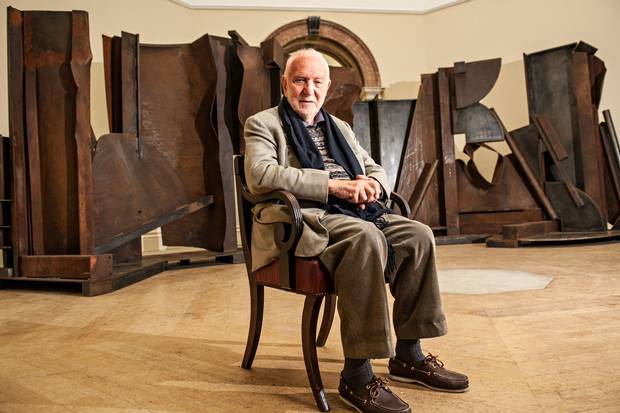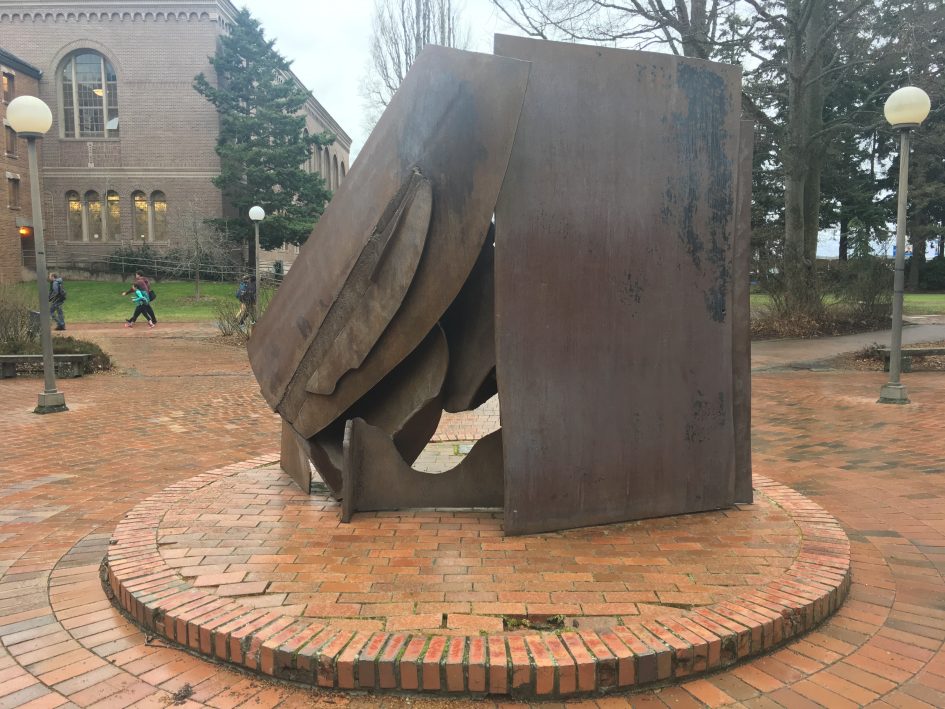
For the past century, English-born Anthony Caro (born on March 8, 1924 and deceased on October 23, 2013) has been one of the primary sculptures in the realm of contemporary art. Not only a sculptor, but a fine artist and painter as well. Caro set the standard for Modern Art, Cubism, and Abstract Expressionism with regards to sculptures. Much of his influence came from Pablo Picasso, as well as David Smith. Anthony Caro’s work India (1976) has many abstract forms, as well as mediums. In almost all his pieces (including India), he works with steel, drawing influence from a handful of cultures such as Indian, Greek, Spanish, and Japanese. His artwork is displayed in many famous museums, ranging from New York’s MOMA to London’s Tate Exhibition. When this artwork came to be in the mid 1970s, he had a great fascination with raw steel and irregular edges of rolled plates.
In this specific piece, Caro displays a handful of India’s traditional architectural elements, as well as his own modernistic touches. It is ironic that in very traditional Indian sculptures, sculptors focus more on linear characteristics than 3-dimensional objects and have very religious contexts. Caro, however, was not a very religious man, and focused his works more so on 3-dimensional sculptures. That being said, in 1977 (a year after completing India), Caro traveled around North America into Western Canada, producing very linear sculptures such as the Emma Lake series. The slits and various linear slabs of steel in India represent beauty in movement and shape, where people of Indian culture would appreciate this symbolic-religious theme. Another similar, more famous sculpture of his was Monsoon (1975). Similar influences are shown in this piece, where he uses big, rolled, and raw/rusted steel screens to display this abstract, vertical sculpture. In almost all of Caro’s work, they follow the pattern of a narrative through the use of not only figures, but also abstraction.
Caro made a few trips to India, saying that he finds “Indian sculpture ver sensual, very full in sculptural terms” (Merrell, 56). Not only that, but he also said that he seeks fresh inspiration through travel, where he has gone to various countries such as Greece, Japan, Italy, France, and Spain. He says that changing your environment helps “to gain fresh stimulus…you’re finding new things about yourself that you would never have found before” (Merrell, 55).
The first clue to deciphering India‘s message is to identify when it was made. Caro constructed it in 1976, which so happens to be a year that India was in the middle of a struggle between dictatorship and democracy. For 21 months, dating from 1975 to 1976, the Prime Minister Indira Gandhi of India had a state of emergency across the country; this catastrophe was due to a war with Pakistan, an oil crisis, and drought that plunged India into a state of economic decline. The order bestowed upon Gandhi gave authority to “rule by decree,” allowing any and all elections to be adjourned and citizen’s civil liberties were restrained. This event became known as The Emergency, where many political figures and journalists that clashed with Ghandi’s ideals were imprisoned, citizens who fought back were either killed or imprisoned, and forced millions of people to be sterilized. In essence, it became one of India’s most controversial periods of history.
In knowing all the information given about this period and place in time, one must question whether or not the construction of India during this period of unrest is simply a coincidence. Through research and thorough analysis, it seems quite unlikely. The upright positioning of the rusted metal being braced by a collection of far more disheveled pieces suggests two opposing forces. Where one side has the luxury of remaining stalwart in its position of power, the other, although hampered by the abuse of the powers that be, persists against the pieces that stand taller than it. The entirety of the piece is rusted, which suggest that although one faction has the upper hand, the atrocities of this conflict affect everyone. Lastly, the perfectly upright pieces indicate the advantage of the government over the people; they remain stable on their foundation, while the slanted, misshapen pieces are forced to lay on a bipod that jut out from the figure in a haphazard, desperate fashion. Such themes reflect the turmoil that were present during that time period. Nonetheless, throughout Caro’s works, we see that dialogue does not just exist with his “modernist ancestors, but within the whole history of sculpture” (Prestel, 1). In addition, he finds fervent provocations outside of his own, personal culture.
Years following his India piece – after Caro had established himself as a high-art sculptor – he began to rewind the clock and focus more on ideas that he had not previously considered in his artworks. Where he once used his raw, rusted steel with jagged edges as his focal element, he then began to look to both American and British influence. This influence reignited a flame of 1940s and 1950s sculpture themes, drawing much influence from David Smith. This period showed signs of “dominant verticals” in sculptures, where it became purely sculptural (3-dimensional) and minimalistic. Much later in his career, he began to turn back to expressionism and humanism in his pieces. He states:
“Every one of my sculptures is about people and feelings…I try to get the sculpture right, the way it wants to go and the way I want it to go. That means living in the work” (Merrell, 24).
Anthony Caro set the high standard for sculptures in contemporary art, and his legacy will be renowned for centuries to come.
- Photo of Anthony Caro provided by “Mutant Eggplant”
- YouTube video provided by “Web of Stories”
Works Cited
Bryant, Julius. Anthony Caro: A Life in Sculpture. London: Merrell, 2004. Print.
Casey, Clare. “Anthony Caro – India.” React Research Execute. N.p., n.d. Web. 08 Feb. 2017.
“The Emergency (India).” Wikipedia. Wikimedia Foundation, n.d. Web. 08 Feb. 2017.
“Feature of Indian Sculptures.” Feature of Indian Sculptures. N.p., n.d. Web. 07 Feb. 2017.
“India in 1976: Major Events and Happenings.” IndiaTodayIn. N.p., 05 Dec. 2005. Web. 07 Feb. 2017.
Rubin, William, and Anthony Caro. Anthony Caro. New York: Museum of Modern Art, 1975. Print.
Wilkin, Karen, Anthony Caro, John Riddy, and Ian Barker. Caro. Munich: Prestel, 1991. Print.
Project Post Credits:
- Ian Peterson – admin, research, photographer
- Stephen Wood – research, editing, organizer








Leave a Reply